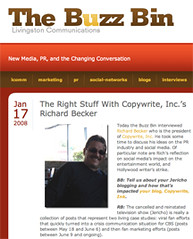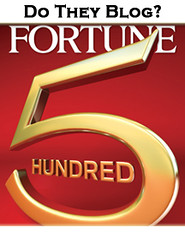Last March, the unabashed shock jock of recruiting, best known to the industry as the “Recruiting Animal,” launched an online radio talk show. Since, the show continues to capture growing interest, maybe even contributing to his recent win as the “Best Recruiting Blogosphere Personality” gratis RecruitingBlogs.com Best Recruiting Blogs Of 2007.
You think? No way, says Animal.
“I feel guilty about the prize because David ‘Bull Doza’ Mendoza of Six Degrees From Dave put me on his slate of candidates and sent a request to his super huge network* to vote as he advised,” explains Animal. “I have to assume that most of the voters didn't know anything about me.”
Whether they did or not, I doubt he feels guilty. At least not since the contest organizer stripped him of one coveted treat. There was no Starbucks coffee in the prize package.
“Have you ever heard the word schnorrer?” asks Animal. “Jay Dee (Jason Davis of RecruitingBlogs.com) is my friend, so he thinks that what's mine is his.”
Adding Practicality To Punch Lines
The Recruiting Animal is not the only one to add podcasting to his repertoire. Since August 2006, BlogTalkRadio has added thousands of shows, including several authors and celebrities in addition to bloggers. It makes some wonder. Is it worth it?
“I think it is easier to get other people to contribute their expertise because they don’t have to write anything,” says Animal. “But it does take preparation to do it well. Writing a good intro for the show is as time consuming as writing a long blog post, but you don't do it every day.”
In addition to the introduction, good online radio hosts have to spend considerable time researching topics and giving the information advanced thought. And, a blog or Web site is important for show promotion.
There is also considerable effort in developing a workable approach. While Animal says he is still in the process of formalizing his interview approach, there are a few things he has learned along the way.
• Always research the featured topic and examples
• Always plan questions thoroughly, including follow ups
• Sometimes pre-interviews can make a huge difference
“I did a pre-interview this past week and it made a big difference,” says Animal. “If I know something about the answers in advance, then I don’t have to struggle to get a clear statement from my guest.”
The pre-interview technique also put him in a position to clarify answers without losing the spontaneity that keeps the show fresh. And, he says, they are more appropriate than supplying advance material or scripts.
While advance material has been helpful for what he affectionately calls “The Animal Panel,” guests tend to know their subject and need more flexibility. On one occasion, he did plan a show with a guest and it backfired, with the guest refusing to stick to the script. Animal filled in some blanks, but the interview seemed like guest baiting to industry insiders as opposed to a fun show.
Balancing Acts For Guests And Listeners
Even with some tried and true tips, there are no hard and fast rules. One of the challenges Animal faces on a weekly basis is finding the right mix for guests and listeners. People don’t necessarily want a plodding question-interview session, but rather a fast-moving, entertaining, and informative show.
If he is too polite to guests, he says it makes for a less interesting show. Most people want what they are used to: blunt remarks, raised voices, and interruptions that sometimes have nothing to do with the subject. So Animal is always looking for balance between his colorful— sometimes snarky — blog persona and a radio show host who doesn’t frighten guests away.
“Since I know that I can find people to interview, I'm probably
better off telling guests that it's going to be a rough ride,” says Animal. “But if I don't sober up, I wonder if it might be hard to get certain interesting, but straight-laced types, on my show.”
Somewhere in between entertaining and outlandish seems to be the answer for him, even if it means losing certain guests to someone else. If he plays it too straight, his listeners let him know. Great introduction, they might say, but what a dull interview.
Live Listeners Are A Fraction Of Audience
Many online radio talk show hosts avoid answering questions related to live listeners, but Animal helped put this into perspective. He says live listeners aren’t as important as some people might think. While he would like more callers because they add value to the show, the bulk of his audience comes from people who download podcasts.
“I derive a lot of benefit from my regular callers. You meet a lot of intelligent, talkative people in blogging. When people like Maureen Sharib, Harry Joiner, Dave Manaster, or Jason Davis call in, they ask good questions that I wouldn't think of,” says Animal. “They also make good remarks and add a lot of variety.”
The show itself, much like The Recruiting Animal’s blog, is geared more for recruiters in the business than it is for recruiting clients and candidates. As a result, readership and listenership tend to be more narrowly focused. However, Animal is still surprised by how many people listen or write reviews of past shows, making podcasts a better measure of his reach.
“I do get the odd review in which someone I don’t know says they find it entertaining,” says Animal. “That’s a real treat.”
Currently, Animal is working to build a subscription network and that might give him a better idea of who and how people listen to the show. This may eventually help produce a show with online sponsors that will keep his Starbucks cup full.
So is it worth it? It seems to be for Animal. But like all online tools, it’s best to match what you do best with the available applications. If you have a good speaking voice and can dedicate time to online radio, it provides a richer experience and relationship than other formats. Animal is a natural for radio, and he didn’t pay me to say it. Listen for yourself.
You can also catch an essay discussion opener on BlogStraigthTalk on adding podcasts.
*note comments: Animal was dreaming.

You think? No way, says Animal.
“I feel guilty about the prize because David ‘Bull Doza’ Mendoza of Six Degrees From Dave put me on his slate of candidates and sent a request to his super huge network* to vote as he advised,” explains Animal. “I have to assume that most of the voters didn't know anything about me.”
Whether they did or not, I doubt he feels guilty. At least not since the contest organizer stripped him of one coveted treat. There was no Starbucks coffee in the prize package.
“Have you ever heard the word schnorrer?” asks Animal. “Jay Dee (Jason Davis of RecruitingBlogs.com) is my friend, so he thinks that what's mine is his.”
Adding Practicality To Punch Lines
The Recruiting Animal is not the only one to add podcasting to his repertoire. Since August 2006, BlogTalkRadio has added thousands of shows, including several authors and celebrities in addition to bloggers. It makes some wonder. Is it worth it?
“I think it is easier to get other people to contribute their expertise because they don’t have to write anything,” says Animal. “But it does take preparation to do it well. Writing a good intro for the show is as time consuming as writing a long blog post, but you don't do it every day.”
In addition to the introduction, good online radio hosts have to spend considerable time researching topics and giving the information advanced thought. And, a blog or Web site is important for show promotion.
There is also considerable effort in developing a workable approach. While Animal says he is still in the process of formalizing his interview approach, there are a few things he has learned along the way.
• Always research the featured topic and examples
• Always plan questions thoroughly, including follow ups
• Sometimes pre-interviews can make a huge difference
“I did a pre-interview this past week and it made a big difference,” says Animal. “If I know something about the answers in advance, then I don’t have to struggle to get a clear statement from my guest.”
The pre-interview technique also put him in a position to clarify answers without losing the spontaneity that keeps the show fresh. And, he says, they are more appropriate than supplying advance material or scripts.
While advance material has been helpful for what he affectionately calls “The Animal Panel,” guests tend to know their subject and need more flexibility. On one occasion, he did plan a show with a guest and it backfired, with the guest refusing to stick to the script. Animal filled in some blanks, but the interview seemed like guest baiting to industry insiders as opposed to a fun show.
Balancing Acts For Guests And Listeners
Even with some tried and true tips, there are no hard and fast rules. One of the challenges Animal faces on a weekly basis is finding the right mix for guests and listeners. People don’t necessarily want a plodding question-interview session, but rather a fast-moving, entertaining, and informative show.
If he is too polite to guests, he says it makes for a less interesting show. Most people want what they are used to: blunt remarks, raised voices, and interruptions that sometimes have nothing to do with the subject. So Animal is always looking for balance between his colorful— sometimes snarky — blog persona and a radio show host who doesn’t frighten guests away.
“Since I know that I can find people to interview, I'm probably
better off telling guests that it's going to be a rough ride,” says Animal. “But if I don't sober up, I wonder if it might be hard to get certain interesting, but straight-laced types, on my show.”
Somewhere in between entertaining and outlandish seems to be the answer for him, even if it means losing certain guests to someone else. If he plays it too straight, his listeners let him know. Great introduction, they might say, but what a dull interview.
Live Listeners Are A Fraction Of Audience
Many online radio talk show hosts avoid answering questions related to live listeners, but Animal helped put this into perspective. He says live listeners aren’t as important as some people might think. While he would like more callers because they add value to the show, the bulk of his audience comes from people who download podcasts.
“I derive a lot of benefit from my regular callers. You meet a lot of intelligent, talkative people in blogging. When people like Maureen Sharib, Harry Joiner, Dave Manaster, or Jason Davis call in, they ask good questions that I wouldn't think of,” says Animal. “They also make good remarks and add a lot of variety.”
The show itself, much like The Recruiting Animal’s blog, is geared more for recruiters in the business than it is for recruiting clients and candidates. As a result, readership and listenership tend to be more narrowly focused. However, Animal is still surprised by how many people listen or write reviews of past shows, making podcasts a better measure of his reach.
“I do get the odd review in which someone I don’t know says they find it entertaining,” says Animal. “That’s a real treat.”
Currently, Animal is working to build a subscription network and that might give him a better idea of who and how people listen to the show. This may eventually help produce a show with online sponsors that will keep his Starbucks cup full.
So is it worth it? It seems to be for Animal. But like all online tools, it’s best to match what you do best with the available applications. If you have a good speaking voice and can dedicate time to online radio, it provides a richer experience and relationship than other formats. Animal is a natural for radio, and he didn’t pay me to say it. Listen for yourself.
You can also catch an essay discussion opener on BlogStraigthTalk on adding podcasts.
*note comments: Animal was dreaming.






















